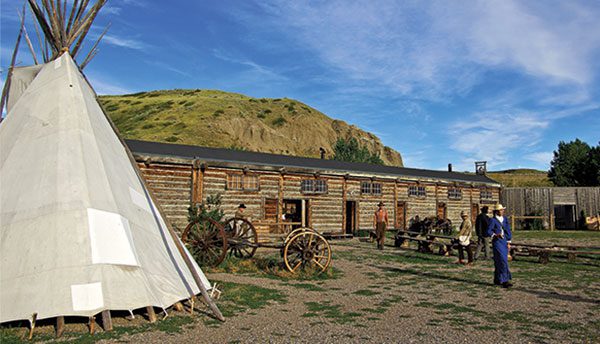Whiskey and Annexation
The 1860-1870s saw lawlessness in the Canadian West in the form of whiskey traders and buffalo robe hunters.
Without formal law they were perpetrating violence among themselves and various First Nations tribes in what is now southern Alberta and Saskatchewan. Ottawa was learning that it was one thing to claim a region and a whole different proposition to hold onto it. The problem of lawlessness leading to a possible loss of the West had been festering as the HBC profits from the fur trade declined and they lost interest in their traditional magisterial role provided by chief factors of the company.
A string of outposts were built in western Alberta and several in the Cypress Hills by independent and somewhat larcenous traders from Montana. Fort Whoop-Up, originally called Fort Hamilton, was the most infamous but there was Fort Slide Out, Fort Stand Off, Fort Kipp and Fort Spitzee as well. There was Farwell’s post and Solomon’s post in the Cypress Hills. They carried out some legitimate trade but the selling of rot gut whiskey was profitable, illegal and led to violence that suggested the area was a political no-man’s-land.

Fort Whoop-Up was built for the first time in 1869 by J. Healy and A. Hamilton, two traders from Fort Benton, Mont. When it burned down it was more sturdily rebuilt at the junction of the Old Man (Belly) and St. Mary’s rivers. Besides the illegal whiskey trade they supposedly flew a flag that looked more American than British on land that after 1867 was Canadian soil. Americans flaunting Canadian law and flying questionable flags seemed like the tip of the annexationist iceberg and was cause for concern in Ottawa. The Cypress Hills Massacre was the final event that pushed the Canadian government into action.
When the North West Mounted Police (NWMP) arrived at Whoop-Up in 1874 they did not find whiskey so they did not close the fort. In 1875 they rented some space at Whoop-Up for the next 12 years until a fire damaged the fort.
The NWMP, established in 1873, would merge with the Dominion Police in 1920 as the foundation for the RCMP. At first they were to be called the North West Mounted Rifles but the U.S. agitated against a Canadian military build-up in the West, so the name was changed to police. They were modelled after the Royal Irish Constabulary and created by legislation from the temporary North West Council approved by the Federal Government. They moved from Toronto to Chicago then to Fort Dufferin, Man. On the U.S. leg of their journey west they travelled on a train with permission from the U.S. government with their weapons and uniforms packed.
When they left Fort Dufferin on July 8, 1874, they consisted of 22 officers, 287 men, 310 horses, various wagons and oxen, plus 50 cows and 40 calves. They were drovers before they acted as police. Their maps were poor and the rations inadequate and they nearly didn’t make it to their destination. A contingent hired Jerry Potts as a guide in Fort Benton and he led them west.
With settlement came criminals, most commonly stock thieves that favoured inaccessible areas. One such area is the Big Muddy Valley, an area of coulees and canyons and hidden springs. Settlement expanded faster on the American side with the existence of Forts Buford and Union providing a market for livestock stolen in Canada. They also developed hideouts like the outlaw caves of the Big Muddy. The caves are hidden in a hillside surrounded by high ground right near the Saskatchewan-Montana border. The outlaws had, over time, extended some wolf dens dug out of the hillside to create the “caves.” There was enough room inside to provide shelter for a handful of men and a few horses and was useful as a summer camp. The hideout was used by such outlaws as Dutch Henry, Sam Kelly (a.k.a. Red Nelson) and the Nelson Jones Gang.
Some ranchers, either for profit or protection, sided with the police or the outlaws — depending on circumstances. To maintain law and order and to show a Canadian presence, the police continued horseback patrols in the area until 1939 when they were cancelled by the outbreak of WWII.

These ranches and road houses often became self-contained communities and hubs of development with post offices, blacksmiths, grist mills, churches, cemeteries, lodgings and stage stops. They increased in size with settlers and homesteaders who believed Confederation would produce an economic boom.
Not all attempts at driving cattle to gold rush markets were initially successful as evidenced by the unworkable Lillooet to Burrard Inlet cattle trail and Norman Lee’s failed attempt to drive 200 head to the Klondike from the Chilcotin. Persistence paid off however, and cattle were eventually driven over Yukon trails to the gold miners. Such entrepreneurs were very interested in the large markets potentially provided by Confederation with Canada and the railroad such a union promised to provide.
Burgeoning populations demanded dependable infrastructure like railroads to deliver products cementing Canadian Confederation with economic development. In the process, culture moved east and west as well as north and south. Today, Boulet cowboy boots are made in St. Tite, Que., where every year there is a popular rodeo and Western festival. The legendary cowboy artist and writer Will James, born Joseph Dufault in 1892 in St. Nazaire de Acton, Que., was lured to the West by its cowboy culture.
While the vagaries of history and geography would define Canada’s differences with the U.S., cowboy culture moving south to north with the cattle herds would link us. Beef products moved east to markets, and investment capital for ranching moved west. Gradually this became a reciprocal flow of products, culture and capital. The West had not only become a place in Canada but it had become a unique culture that moved along the very rails that serviced Confederation.













